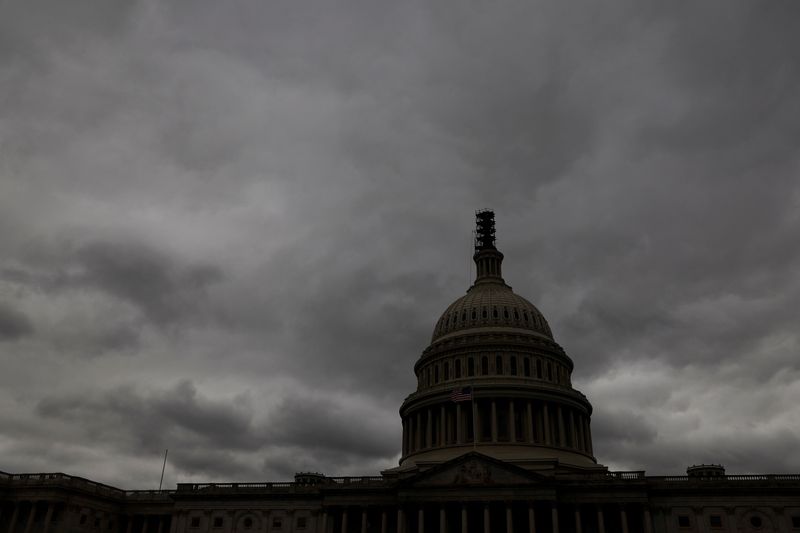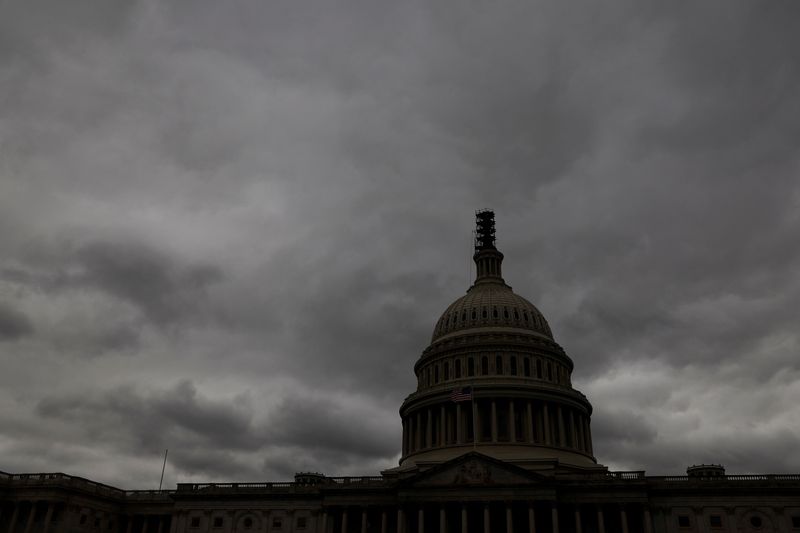Commodities
Factbox-US government shutdown: agriculture data hit


© Reuters. FILE PHOTO: A general view of the U.S. Capitol, where Congress will return Tuesday to deal with a series of spending bills before funding runs out and triggers a partial U.S. government shutdown, in Washington, U.S. September 25, 2023. REUTERS/Jonathan E
CHICAGO (Reuters) – The release of commodity market-sensitive reports released by the U.S. Department of Agriculture (USDA) and other government agencies will be suspended if Congress fails to provide the government with funding for the fiscal year starting Sunday.
During shutdowns, nonessential government employees are typically furloughed, or placed on temporary unpaid leave. Workers deemed essential, including those dealing with public safety, food safety, and national security, keep working.
Private exchange operators such as the CME Group (NASDAQ:) are generally not affected. But routine government reports have in the past been delayed until the government reopens.
“Market reporters will pause USDA’s market news reports that help farmers, ranchers, commodity traders, and buyers determine the market value of goods, creating uncertainty in the marketplace with detrimental ripple effects for farmers who need to sell their products,” a USDA spokesperson said.
Below is a schedule of key reports planned for release in October and how they may be affected, depending on how long a shutdown lasts.
Monday, Oct. 2:
Weekly U.S. grain export inspections data, released by USDA’s Agricultural Marketing Service each Monday at 11 a.m. ET (1500 GMT), will not be published, according to the USDA spokesperson. Inspections reports were released during the 2019 shutdown as some personnel continued to work.
Monthly reports on U.S. grain crushings and fats and oils, including U.S. soy crushings, released by USDA’s National Agricultural Statistics Service (NASS) on the first business day of each month at 3 p.m. ET (1900 GMT), would also be suspended.
A weekly U.S. crop progress report, released by USDA’s NASS each Monday at 4 p.m. ET (2000 GMT), would be suspended, according to the USDA spokesperson. Farmers and traders rely on the report for harvest progress and crop condition data.
Wednesday, Oct. 4:
The U.S. Energy Information Administration said on Friday that a government shutdown would not have any immediate impact on the release schedule for its weekly oil inventory data, which includes figures on production and stocks of corn-based ethanol. The EIA releases its report each Wednesday at 10:30 a.m. ET/1430 GMT.
Thursday, Oct. 5:
Weekly U.S. export sales data, released by USDA’s Foreign Agricultural Service each Thursday at 8:30 a.m. ET (1230 GMT), would be suspended. Multiple weeks of export sales data delayed by two previous government shutdowns were later released in single, combined reports once the government reopened.
USDA Under Secretary for Trade and Foreign Agricultural Affairs Alexis Taylor told reporters on Thursday the export sales report “is not produced while the government is shut down.” Taylor said the report “is a critical tool for market intelligence for our exporters and for our industry in the United States.”
Friday, Oct. 6:
The U.S. Commodity Futures Trading Commission’s weekly Commitments of Traders reports, which detail the size of positions in options and futures, will not be published if there is a shutdown, a CFTC spokesperson said. When the reports were disrupted during the last shutdown, CFTC backfilled the data over a period of weeks after the government reopened. Released each Friday at 3:30 p.m. ET (1930 GMT).
Thursday, Oct. 12:
The monthly World Agricultural Supply and Demand report, set for release by USDA’s World Agricultural Outlook Board at noon ET (1600 GMT), would be suspended, according to a spokesperson for USDA’s Office of the Chief Economist. Farmers and traders are counting on the monthly report for an update on the size of the U.S. soy and corn harvests and how much the crops have been affected by late-summer dry weather.
Monthly crop production data, released each month by USDA’s NASS at noon ET(1600 GMT), would be suspended.
Friday, Oct. 20:
Monthly cattle on feed report, released by USDA’s NASS at 3 p.m. ET (2000 GMT), would be suspended, according to a USDA spokesperson. The report gives livestock traders and ranchers an estimate of the number of cattle in feedlots at a time when the U.S. herd is shrinking.
Wednesday, Oct. 25:
Monthly cold storage report, released by USDA’s NASS at 3 p.m. ET (2000 GMT), would be suspended, according to a USDA spokesperson. The report details supplies of everything from frozen meats to orange juice in storage.
Commodities
Oil prices rise; U.S. crude inventories plunge, Russia-Ukraine truce eyed
Commodities
India’s Reliance to stop buying Venezuelan oil over US tariffs, sources say
Commodities
Oil prices climb on Venezuela supply worries

 Forex3 years ago
Forex3 years agoForex Today: the dollar is gaining strength amid gloomy sentiment at the start of the Fed’s week

 Forex3 years ago
Forex3 years agoUnbiased review of Pocket Option broker

 Forex3 years ago
Forex3 years agoDollar to pound sterling exchange rate today: Pound plummeted to its lowest since 1985

 Forex3 years ago
Forex3 years agoHow is the Australian dollar doing today?

 Cryptocurrency3 years ago
Cryptocurrency3 years agoWhat happened in the crypto market – current events today

 World3 years ago
World3 years agoWhy are modern video games an art form?

 Commodities3 years ago
Commodities3 years agoCopper continues to fall in price on expectations of lower demand in China

 Economy3 years ago
Economy3 years agoCrude oil tankers double in price due to EU anti-Russian sanctions























